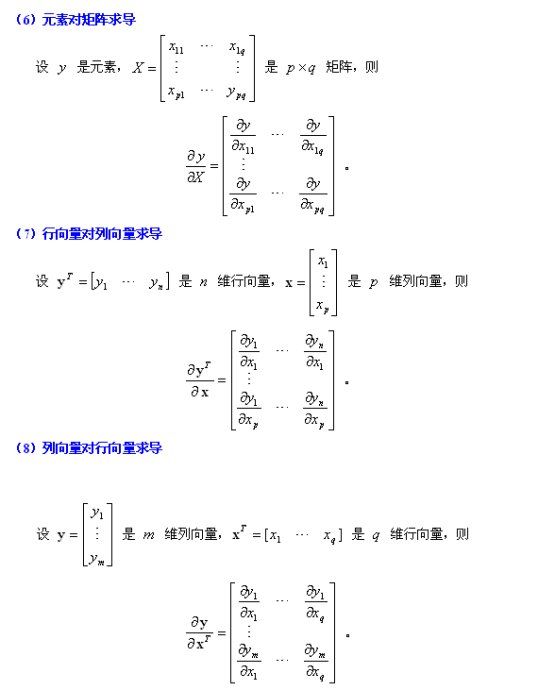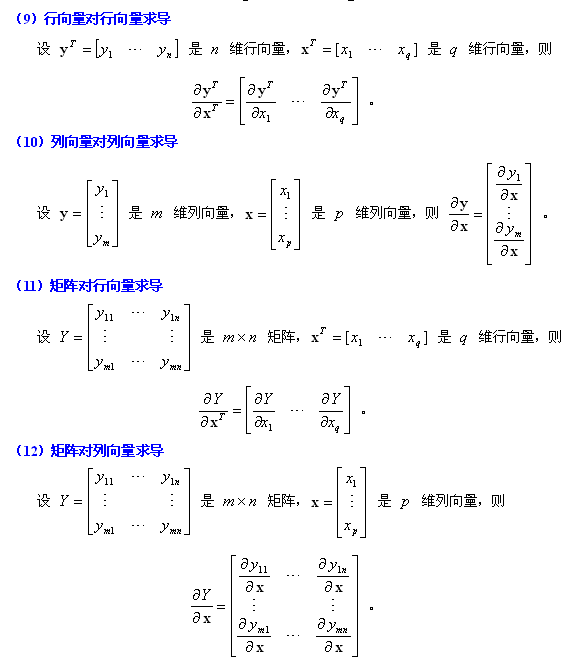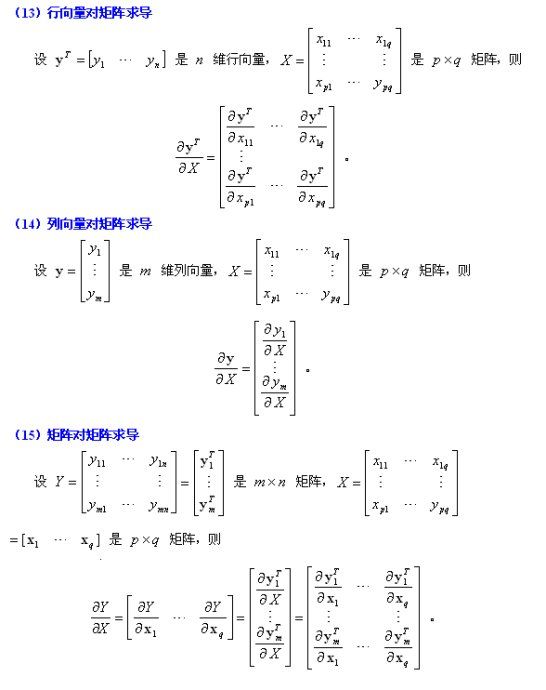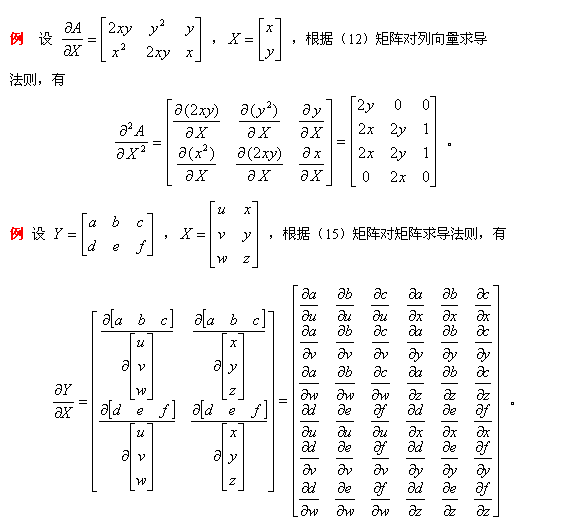矩阵求导计算法则
转自:http://blog.sina.com.cn/s/blog_4a033b090100pwjq.html
求导公式(撇号为转置):
Y = A * X --> DY/DX = A'
Y = X * A --> DY/DX = A
Y = A' * X * B --> DY/DX = A * B'
Y = A' * X' * B --> DY/DX = B * A'
![]() 乘积的导数
乘积的导数
d(f*g)/dx=(df'/dx)g+(dg/dx)f'
于是把以前学过的矩阵求导部分整理一下:
1. 矩阵Y对标量x求导:
相当于每个元素求导数后转置一下,注意M×N矩阵求导后变成N×M了
Y = [y(ij)]--> dY/dx = [dy(ji)/dx]
2. 标量y对列向量X求导:
注意与上面不同,这次括号内是求偏导,不转置,对N×1向量求导后还是N×1向量
y = f(x1,x2,..,xn) --> dy/dX= (Dy/Dx1,Dy/Dx2,..,Dy/Dxn)'
3. 行向量Y'对列向量X求导:
注意1×M向量对N×1向量求导后是N×M矩阵。
将Y的每一列对X求偏导,将各列构成一个矩阵。
重要结论:
dX'/dX =I
d(AX)'/dX =A'
4. 列向量Y对行向量X’求导:
转化为行向量Y’对列向量X的导数,然后转置。
注意M×1向量对1×N向量求导结果为M×N矩阵。
dY/dX' =(dY'/dX)'
5. 向量积对列向量X求导运算法则:
注意与标量求导有点不同。
d(UV')/dX =(dU/dX)V' + U(dV'/dX)
d(U'V)/dX =(dU'/dX)V + (dV'/dX)U'
重要结论:
d(X'A)/dX =(dX'/dX)A + (dA/dX)X' = IA + 0X' = A
d(AX)/dX' =(d(X'A')/dX)' = (A')' = A
d(X'AX)/dX =(dX'/dX)AX + (d(AX)'/dX)X = AX + A'X
6. 矩阵Y对列向量X求导:
将Y对X的每一个分量求偏导,构成一个超向量。
注意该向量的每一个元素都是一个矩阵。
7. 矩阵积对列向量求导法则:
d(uV)/dX =(du/dX)V + u(dV/dX)
d(UV)/dX =(dU/dX)V + U(dV/dX)
重要结论:
d(X'A)/dX =(dX'/dX)A + X'(dA/dX) = IA + X'0 = A
8. 标量y对矩阵X的导数:
类似标量y对列向量X的导数,
把y对每个X的元素求偏导,不用转置。
dy/dX = [Dy/Dx(ij) ]
重要结论:
y = U'XV= ΣΣu(i)x(ij)v(j) 于是 dy/dX = [u(i)v(j)] =UV'
y = U'X'XU 则dy/dX = 2XUU'
y =(XU-V)'(XU-V) 则 dy/dX = d(U'X'XU - 2V'XU + V'V)/dX = 2XUU' - 2VU' +0 = 2(XU-V)U'
9. 矩阵Y对矩阵X的导数:
将Y的每个元素对X求导,然后排在一起形成超级矩阵。
10.乘积的导数
d(f*g)/dx=(df'/dx)g+(dg/dx)f'
结论
d(x'Ax)=(d(x'')/dx)Ax+(d(Ax)/dx)(x'')=Ax+A'x (注意:''是表示两次转置)
Notation
- d/dx (y) is a vector whose (i) element is dy(i)/dx
- d/dx (y) is a vector whose (i) element is dy/dx(i)
- d/dx (yT) is a matrix whose (i,j) element is dy(j)/dx(i)
- d/dx (Y) is a matrix whose (i,j) element is dy(i,j)/dx
- d/dX (y) is a matrix whose (i,j) element is dy/dx(i,j)
Note that the Hermitian transpose is not used because complex conjugates are not analytic.
In the expressions below matrices and vectors A, B, C do not depend on X.
Derivatives of Linear Products
- d/dx (AYB) =A * d/dx (Y) * B
-
- d/dx (Ay) =A * d/dx (y)
- d/dx (xTA) =A
-
- d/dx (xT) =I
- d/dx (xTa) = d/dx (aTx) = a
- d/dX (aTXb) = abT
-
- d/dX (aTXa) = d/dX (aTXTa) = aaT
- d/dX (aTXTb) = baT
- d/dx (YZ) =Y * d/dx (Z) + d/dx (Y) * Z
Derivatives of Quadratic Products
- d/dx (Ax+b)TC(Dx+e) = ATC(Dx+e) + DTCT(Ax+b)
-
- d/dx (xTCx) = (C+CT)x
-
- [C: symmetric]: d/dx (xTCx) = 2Cx
- d/dx (xTx) = 2x
- d/dx (Ax+b)T (Dx+e) = AT (Dx+e) + DT (Ax+b)
-
- d/dx (Ax+b)T (Ax+b) = 2AT (Ax+b)
- [C: symmetric]: d/dx (Ax+b)TC(Ax+b) = 2ATC(Ax+b)
- d/dX (aTXTXb) = X(abT + baT)
-
- d/dX (aTXTXa) = 2XaaT
- d/dX (aTXTCXb) = CTXabT + CXbaT
-
- d/dX (aTXTCXa) = (C + CT)XaaT
- [C:Symmetric] d/dX (aTXTCXa) = 2CXaaT
- d/dX ((Xa+b)TC(Xa+b)) = (C+CT)(Xa+b)aT
Derivatives of Cubic Products
- d/dx (xTAxxT) = (A+AT)xxT+xTAxI
Derivatives of Inverses
- d/dx (Y-1) = -Y-1d/dx (Y)Y-1
Derivative of Trace
Note: matrix dimensions must result in an n*n argument for tr().
- d/dX (tr(X)) = I
- d/dX (tr(Xk)) =k(Xk-1)T
- d/dX (tr(AXk)) = SUMr=0:k-1(XrAXk-r-1)T
- d/dX (tr(AX-1B)) = -(X-1BAX-1)T
- d/dX (tr(AX-1)) =d/dX (tr(X-1A)) = -X-TATX-T
- d/dX (tr(ATXBT)) = d/dX (tr(BXTA)) = AB
- d/dX (tr(XAT)) = d/dX (tr(ATX)) =d/dX (tr(XTA)) = d/dX (tr(AXT)) = A
- d/dX (tr(AXBXT)) = ATXBT + AXB
- d/dX (tr(XAXT)) = X(A+AT)
- d/dX (tr(XTAX)) = XT(A+AT)
- d/dX (tr(AXTX)) = (A+AT)X
- d/dX (tr(AXBX)) = ATXTBT + BTXTAT
- [C:symmetric] d/dX (tr((XTCX)-1A) = d/dX (tr(A (XTCX)-1) = -(CX(XTCX)-1)(A+AT)(XTCX)-1
- [B,C:symmetric] d/dX (tr((XTCX)-1(XTBX)) = d/dX (tr( (XTBX)(XTCX)-1) = -2(CX(XTCX)-1)XTBX(XTCX)-1 + 2BX(XTCX)-1
Derivative of Determinant
Note: matrix dimensions must result in an n*n argument for det().
- d/dX (det(X)) = d/dX (det(XT)) = det(X)*X-T
-
- d/dX (det(AXB)) = det(AXB)*X-T
- d/dX (ln(det(AXB))) = X-T
- d/dX (det(Xk)) = k*det(Xk)*X-T
- d/dX (ln(det(Xk))) = kX-T
- [Real] d/dX (det(XTCX)) = det(XTCX)*(C+CT)X(XTCX)-1
-
- [C: Real,Symmetric] d/dX (det(XTCX)) = 2det(XTCX)* CX(XTCX)-1
- [C: Real,Symmetricc] d/dX (ln(det(XTCX))) = 2CX(XTCX)-1
Jacobian
If y is a function of x, then dyT/dx is the Jacobian matrix of y with respect to x.
Its determinant, |dyT/dx|, is the Jacobian of y with respect to x and represents the ratio of the hyper-volumes dy and dx. The Jacobian occurs when changing variables in an integration: Integral(f(y)dy)=Integral(f(y(x)) |dyT/dx| dx).
Hessian matrix
If f is a function of x then the symmetric matrix d2f/dx2 = d/dxT(df/dx) is the Hessian matrix of f(x). A value of x for which df/dx = 0 corresponds to a minimum, maximum or saddle point according to whether the Hessian is positive definite, negative definite or indefinite.
- d2/dx2 (aTx) = 0
- d2/dx2 (Ax+b)TC(Dx+e) = ATCD + DTCTA
-
- d2/dx2 (xTCx) = C+CT
-
- d2/dx2 (xTx) = 2I
- d2/dx2 (Ax+b)T (Dx+e) = ATD + DTA
-
- d2/dx2 (Ax+b)T (Ax+b) = 2ATA
- [C: symmetric]: d2/dx2 (Ax+b)TC(Ax+b) = 2ATCA




